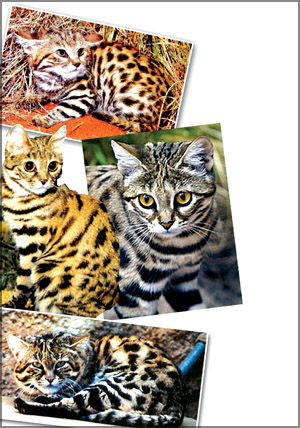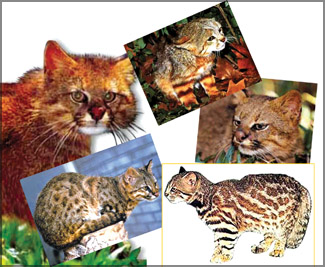|
Felines - small, wild and beautiful II
Spotted beauties from two continents
Last
week we introduced some small, furry friends who are the 'wild' cousins
of your lovable feline friends at home. We familiarise you with two more
members from the cat family who may look as cute as your pet cat, but
may not be as docile, since they live in the wild in Africa and South
America.
Some of them are kept as exotic
pets or in zoos but, they are best left in their own natural habitats -
wild and free! As we were informed by some wildlife enthusiasts that
there are small wild cats endemic to our country too, we decided to
investigate into this... We learnt that even though there are a couple
of small wild cats found only in Sri Lanka, they are not classified as
endemic since they are only a sub species.
Anyway, as promised, we will try
to enlighten you about these cats in our future issues. Anyone who has
information of these small, wild cats found here is most welcome to send
it to us so that we could share it with our readers.
Meanwhile, let's check out some
interesting facts about the Black-footed cat and the Pampas cat.
Black-footed cat
A solitary animal, the black-footed cat (Felis nigripes) is one of
the smallest species in the family of cats. It is the most fascinating
among the small, wild cats and is considered exceptionally fierce
compared to its size. Two sub species of the black-footed cat have been
identified.
These small wild cats are distributed only in three Southern African
countries - Namibia, Botswana and South Africa, and marginally in
Zimbabwe. They are also called the little spotted cats and ant-hill
tigers. They are found in habitats such as arid semi-deserts and the
savannah.
Described as a rare species by some experts, black-footed cats are
generally shy animals that seek refuge at the slightest disturbance. The
habit of hiding in abandoned anthills or termite mounds is one of the
reasons they are known as anthill tigers.
The other reason being their courage. It has been said that though
small in size, these cats are brave animals that defend themselves
fiercely when confronted. In fact, according to legends of the Bushmen,
the black-footed cat can even kill a giraffe by piercing its jugular
(one of three large veins in the neck) vein.
 Even
though this may be an exaggeration, there is historical evidence of
these wild cats killing sheep and goat by hanging on to the jugular vein
until it pierces. Apart from the abandoned anthills, they also take
refuge in places such as burrows and under rock slabs. Even
though this may be an exaggeration, there is historical evidence of
these wild cats killing sheep and goat by hanging on to the jugular vein
until it pierces. Apart from the abandoned anthills, they also take
refuge in places such as burrows and under rock slabs.
By now, you must be aware that most small wild cats resemble the
domestic cat, or your pet cat in general appearance. However, unlike the
domestic cats, the wild counterparts have very distinctive fur coats;
more like the ones the big cats wear!
Let's then check out what the black footed cat's appearance is like.
The background colour of the pelage (French word for coat, pronounced as
pel'ij) varies from light sandy brown to reddish brown or cinnamon, buff
to tawny or off-white, with dark, black spots, which sometimes coalesce
(come together) into broken stripes.
The legs are barred with dark horizontal stripes. The black-tipped
tail is banded with dark rings. Like the name suggests, the pads on the
feet are black and surrounded by long, black hair. The hair protects the
feet from the heat of the semi-desert habitats the animal lives in.
The cat has a large, broad head in proportion to its small body and
is about 22 cm (9 inches) at shoulder height. Its body length is 19-24
inches. The male cat weighs about 2.2 kg while the female, which is
considered to be the smallest of the wild cats weighs, only 1.5 kg.
These cats have rounded ears, very large eyes and short tails. Unlike
in most spotted cats, the skin of black-footed cats is an unpigmented
pink.
Secretive and rarely seen in the wild, these species of cats are
opportunistic hunters. They share the home range with African lions and
cheetahs. As they have healthy appetites and consume 1/5th or 20 per
cent of their body weight each night, they hunt a lot.
Every half an hour, an attempt at hunting is made with a 60 per cent
success rate. They kill and eat a small bird or mammal every 50 minutes
on average, thereby consuming around 10-15 numbers of prey per night.
Their hunting techniques, which include flushing of birds' nests and
'wait and stalk' techniques vary according to the prey. Sometimes they
could be seen scavenging on larger prey, especially mammals killed by
their bigger cousins, their diet includes rodents such as gerbils and
ground squirrels, small mammals, birds and also reptiles, spiders and
insects.
It is said that these cats are virtually water independent, deriving
their moisture requirements mostly from food. However, they do drink
water when it's available. The females give birth to a litter of 1-3
kittens (typically two), after a gestation period of 65 days.
The development of the kittens is better than the domestic cat and
the kittens which weigh between 60-90 gr. at birth, gain around eight
grammes daily. The mother changes the den quite often when she has a
litter of kittens.
Several distinctive mannerisms, and vocalisations have been observed
by researchers in females. According to one report, in times of danger,
the mother protects the kittens using a special technique. She first
alerts the kittens to the danger so that instead of running to her for
safety, the kittens freeze wherever they are.
They will only move once again when the mother makes a low call,
accompanied by a vertical movement of the ears. The males are said to
have loud calls which are often linked to a high pitch roar.
These delicate and beautiful specie of wild cats are difficult to
bring up in captivity as they need specialised care. They are known to
live upto 13 years in the wild.
Pampas cat
Even though some of you may be familiar with the name pampas which
refers to a large, treeless plain in South America, many of you would
not have heard of the pampas cat (Oncifelic colocolo).
It is yet another species of small wild cat found mostly in Ecuador,
Bolivia, Uruguay, Paraguay, Peru, Brazil, Chile and Argentina. It is
different from other South American wild cats and resemble more the
European wildcat.
It has a greater geographical area than other small wild cats and are
found in primarily open grassland and humid forest habitats.
It has a broad face, pointed ears, pink nose, relatively large amber
eyes, short and stout legs, a fairly short but bushy tail and short
muzzle. It is similar in appearance to a robust domestic cat.
The colouration of the coat varies from area to area. For instance,
in the High Andes, the coat is grey with reddish stripes, broken up into
spots. In Argentina the fur coats are longer, more yellowish brown and
have muted patterns while in Brazil, the coats are rusty coloured with
irregular black stripes.
The back of the ears is grey and in some species, there is a central
white spot. Black rings mark the tail. Two brown bands run from the eyes
across the cheeks, meeting beneath the throat. Bands of yellow or brown
run obliquely from the back to the flanks, and a brown band runs around
the upper part of the forelegs.
 The
thickness of fur varies from region to region with the pampas cats in
colder areas having thick, soft coats and those in warmer areas having
straw-like fur coats. In some species, the long fur may even form a mane
on the back, up to 7 cm long. The
thickness of fur varies from region to region with the pampas cats in
colder areas having thick, soft coats and those in warmer areas having
straw-like fur coats. In some species, the long fur may even form a mane
on the back, up to 7 cm long.
Sometimes referred to as 'gato pajero' or the 'gross cat' in
Argentina, the pampas cat's diet comprises small mammals, guinea pigs,
ground dwelling birds, rodents, penguin eggs and small chicks from
nests.
The pampas cat is a good climber and a nocturnal creature. The
females give birth to about 2-3 kittens after a gestation period of
80-85 days. It could live up to 16 years in captivity, but in the wild
its lifespan does not exceed 9-10 years.
While enlightening you about the pampas cat, we'd like to also focus
your attention to its main habitat, the pampas from which the cat has
got its name.
The pampas is a flat, fertile plain that covers an area of 300,000 sq
miles or 777,000 sq kilometres from the Atlantic Ocean to the Andean
Mountains found primarily in Argentina and extending into Uruguay.
It is one of the most endangered habitats of the Earth due to
domestic livestock and farming. The humid pampas eco-region is a
savannah-like grassland mosaic dominated by bunch grasses scattered with
shrubs and small trees.
It is one of the richest grazing areas of the world. The semi-arid
pampas' eco-region, which is also a rich grassland, is dominated by
tufts of grasses, trees and shrubs. Today no pristine (unspoilt) area
remains in this once vast sea of grass.
Like many of the other creatures that are facing problems due to loss
of habitation, the pampas cat too is under threat due to the declining
conditions of the pampas and also because of its incredibly diverse coat
colouration and markings which attract many in the fur trade.
We will bring you more interesting facts on the many species of small
wild cats in our forthcoming issues.
The pampas cat is only 55 to 70 cm (22 to 28 in) in length and weighs
about 3 to 7 kg (6.6 - 15.5 lbs) in average. |
